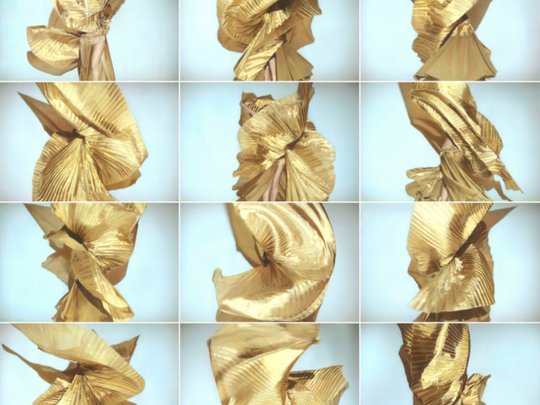
Despite having lived abroad for a decade, New York-based Egyptian artist Youssef Nabil is deeply engaged with the sociopolitical situation in his homeland. His latest exhibition, “Time of Transformation”, expresses his anguish about the changes taking place in Egyptian society after the recent revolution. The show features three new series of artworks titled “The Veiled Women”, “The Last Dance” and “Transformation”.
Created with his signature technique of painting by hand on silver gelatin photographs, the artworks express Nabil’s concerns about the fading away of Egypt’s secular and artistic traditions and the emergence of a new culture of intolerance and discrimination.
“Even if you are not living in your country, you always carry your culture and your national identity inside you. But, suddenly, these have been stolen from me. I grew up in a [land] where people from different religions lived in harmony. And seeing that idea of Egypt disappearing is extremely disturbing. This show is about the mental and psychological transformation going on inside me as I struggle to let go of old values and deal with the changes in Egyptian society,” Nabil says.
For “The Veiled Women” series, the artist asked well-known women artists, film stars and musicians such as Catherine Deneuve, Isabella Rosselini and Alicia Keys to pose for him wearing the traditional Mediterranean veil. His hand-painted portraits of these beautiful women look like figures from classical paintings.
“I wanted to draw attention to the fact that wearing a veil is an age-old Mediterranean tradition, but today in Egypt, this graceful and beautiful cultural element has become a means of judging people or discriminating between people based on religion and gender,” Nabil says.
Similarly, in “The Last Dance”, the artist takes a nostalgic look at the fast disappearing traditional Egyptian art form of belly dancing. His images capture a series of whirling movements of a belly dancer, dressed in a traditional belly dancing costume. The dancer’s face is hidden behind the swirls of her golden dress, making the images appear like abstract compositions. Flashes of her bare body seen in some of the images impart a touch of sensuality to the pictures, hinting at the reason that is threatening the survival of this art form in today’s political and cultural environment of Egypt.
“My generation grew up watching belly dancing in films, theatre and at weddings, and we love the music, the graceful movements and the beautiful costumes of the traditional dancers. But this art form has been vulgarised over the years and today, with theatres being closed down and dancers being targeted, it is fast disappearing. It makes me sick to see that one of the most beautiful things in our culture is dying. The pictures highlight the contrast between the decent, traditional way of belly dancing and the way it is seen now. I have tried to portray the dancers as butterflies fluttering their wings in a last dance, desperately trying to resist death.
“The deeper connotation of ‘The Last Dance’ is that at this time in the history of Egypt, the situation is such that anything could be for the last time. I am very sad about what is happening in Egypt today, but all I can do is to try to protect our Egyptian identity and culture through my work and remain optimistic about the future,” Nabil says.
In the “Transformation” panels, Nabil asked performance artiste Marina Abramovich and French actress Isabelle Huppert to act out their interpretation of what he is feeling. His photographs of these dramatic enactments are essentially self portraits depicting his reactions to the transformations that are taking place around him and within him. The pictures document not only the struggle that Egyptians are going through, but also of all human beings as they grapple with the constant changes around them.
Nabil’s work is inspired by his love for cinema. “I often use multiple panels in my work because I like to tell my stories in a cinematic way. My early work reflected my love for old Egyptian black-and-white films. When I wanted to use colour in my work I started painting the prints by hand, using charcoal, pencils, acrylic and oil paints. Studios used to do this in the past and I like this connection between photography and painting, so I tracked down people who specialised in this technique in the 1940s and 1950s and learnt it from them,” he says.
The artist’s interest in cinema led him to make a short film, “You Never Left”, which was screened at the opening of the Mathaf Arab Museum of Modern Art, Doha, and is now being shown at his exhibition in Dubai. The visually beautiful and extremely moving film speaks about what it means to live away from your country.
“This is a self portrait. It depicts my feeling that leaving your country is akin to dying,” Nabil says.
Time of Transformation will run at The Third Line, Al Quoz until June 12.
BOX:
Two of Nabil’s artworks — “Natacha and Crown” and “Lonely Pasha” — are now part of the Guggenheim Abu Dhabi’s permanent collection; and the artist was invited to speak about his work at the Guggenheim Abu Dhabi: Talking Art Series, organised by the museum this month. “I could never have imagined that we would have such prestigious museums in this region. Having my work in the museums in Doha and Abu Dhabi feels like a dream,” he says.


